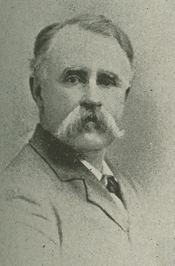Name Peter Otey Service/branch Confederate Army | Occupation businessman Party Democratic Party Political party Democratic Party Role U.S. representative Resigned May 4, 1902 | |
 | ||
Born December 22, 1840Lynchburg, Virginia ( 1840-12-22 ) Allegiance Confederate States of America Education | ||
Peter Johnston Otey (December 22, 1840 – May 4, 1902) was a U.S. Representative from Virginia.
Contents
Born in Lynchburg, Virginia, Otey attended private schools in Lynchburg, and graduated from the Virginia Military Institute at Lexington in 1859. Otey joined the Confederate States Army in 1861 and served as a major throughout the Civil War.
He started out his professional life as a cashier for the Lynchburg National Bank and was later named the general manager of the Rivermont Land Co. Starting in 1887 he organized and built the Lynchburg & Durham Railroad and became president of the company which in 1892 merged with the Norfolk and Western railway. He retired from the railroad on June 21, 1891.
Otey was elected as a Democrat to the Fifty-fourth and to the three succeeding Congresses and served from March 4, 1895, until his death. He served as delegate to the Democratic National Convention in 1896. He died in Lynchburg, Virginia, May 4, 1902 and was interred in the Presbyterian Cemetery.
Early life
Peter J. Otey was born on December 22, 1840 in Lynchburg, Virginia to Lucy (née Norvell) and John Mathews Otey. He was a nephew of Bishop James Hervey Otey. He attended the Virginia Military Institute, graduating in 1859 with a degree in civil engineering. In the year of his graduation he and his fellow cadets were sent to combat John Brown's raid on Harpers Ferry.
Civil War service
On the outbreak of the American Civil War he enlisted in the Confederate States Army. He was assigned to the 51st Virginia Infantry in the Army of the Kanawha, with which he fought at Fort Donelson. He was promoted to major of the 13th Virginia Infantry in General Lee's Army of Northern Virginia, with which he fought numerous battles and was injured at the Battle of Newmarket. He was captured at Waynesboro and taken as a prisoner of war to Delaware, where he remained until the end of the war.
